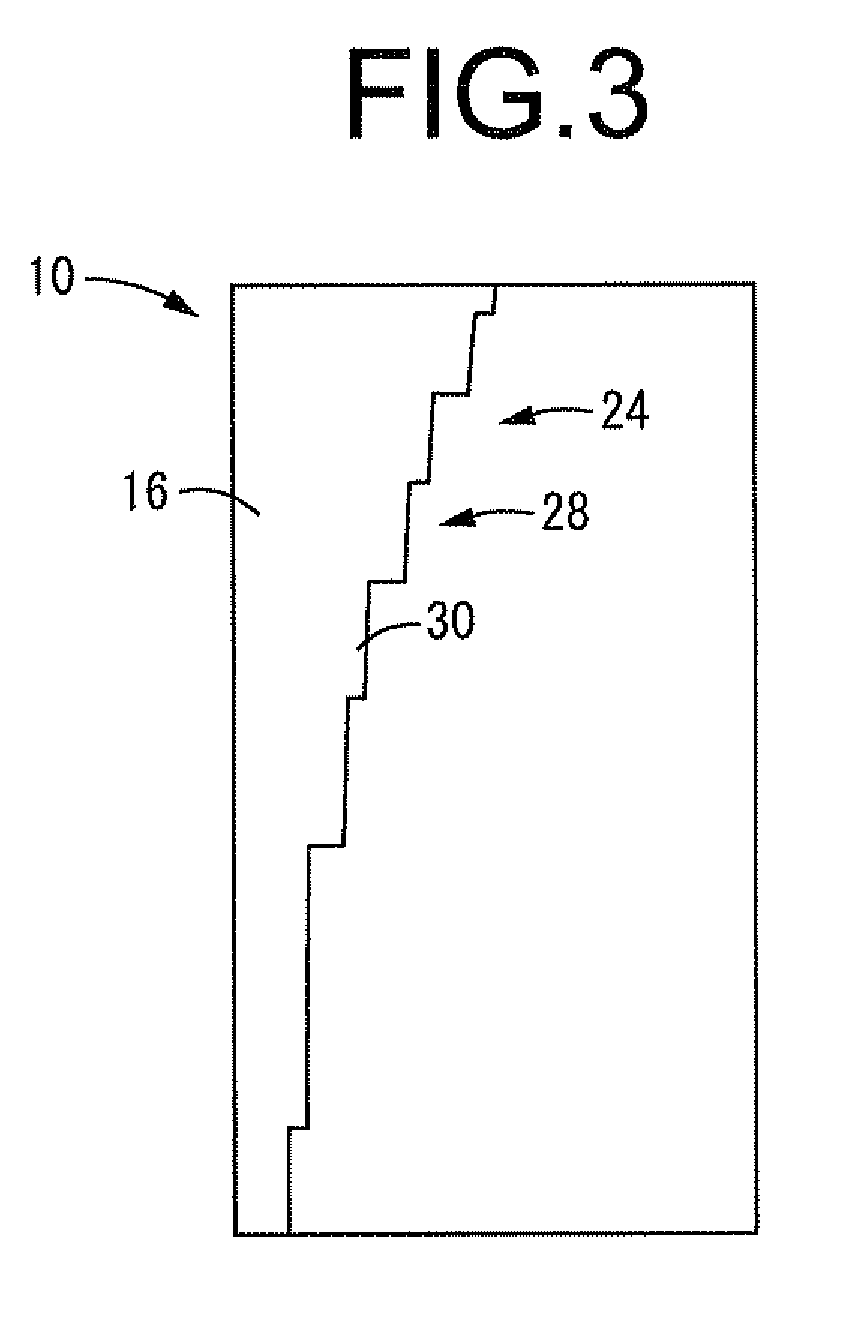Method of manufacturing a diffraction lens other than an aphakic intraocular lens
a technology of aphakic intraocular lens and a manufacturing method, which is applied in the direction of intraocular lens, instruments, spectales/goggles, etc., can solve the problems of reducing the contrast in the intermediate vision range, reducing the efficiency of diffraction lens, and increasing the difficulty of adjusting the aperture. effect of the lens eccentricity
- Summary
- Abstract
- Description
- Claims
- Application Information
AI Technical Summary
Benefits of technology
Problems solved by technology
Method used
Image
Examples
first embodiment
[0110]First of all, FIG. 1 shows a front view diagram of a contact lens 10 as a first embodiment related to the diffraction lens in this invention, and FIG. 2 shows a side view of the contact lens 10. Here in FIGS. 1 and 2, a relief pattern 30 described later is shown with its size exaggerated for better understanding.
[0111]The contact lens 10 comprises a lens's rear surface 12 in an approximate concave shape of a sphere as a whole and a lens's front surface 14 with an approximate convex shape of a sphere as a whole, and is, in its entirety, in an approximate shape of a spherical shell. Also, the center part of the contact lens 10 is made to be an optical part 16 in a round shape in front view, which can exert the effect of prescribed vision corrections on the wearer. Furthermore, the peripheral part of the contact lens 10 located around the optical part 16 is made to be a peripheral part 18 in an annular shape in front view, which securely holds the contact lens 10 at a given posit...
second embodiment
[0164]First, FIG. 12 shows a relief profile of a relief pattern 50 as this invention. In the present embodiment, a synchronous structure is set up where two reliefs with the dioptric power at +3.0 D for near vision and the other at +1.0 D for intermediate vision are periodically overlapped. By the way, the relief profile of the present embodiment is the one obtained under the following conditions:
[0165]Radius of the base curve of the rear optical part=8.000 mm
[0166]Dioptric power of the rear optical part=+5.0 D
[0167]Refractive index of the lens material=1.500
[0168]Refractive index of the surrounding medium=1.336
[0169]Designed wavelength=500 nm
[0170]Zone constant of the relief for near vision ‘a’=1
[0171]Meanwhile, the grating pitch is larger in the relief for intermediate vision than in the relief for near vision.
[0172]Especially in the present embodiment, two relief depths of the relief for near vision are provided per each zone of the relief for intermediate vision, and these three...
third embodiment
[0175]Next, FIG. 14 shows a relief profile of a relief pattern 60 as this invention. In the present embodiment, a synchronous structure is set up where two reliefs with the dioptric power at +3.0 D for near vision and at +1.0 D for intermediate vision are periodically overlapped. Meanwhile, the grating pitch is larger in the relief for intermediate vision than in the relief for near vision.
[0176]In the present embodiment, two relief depths of the relief for near vision are provided per each zone of the relief for intermediate vision, and these three zones in total are formed, that is, in one out of three zone radii of the relief for near vision, the zone radius of the relief for intermediate vision is made equal to that of the relief for near vision. And, in each zone of the relief for intermediate vision composed of an overlap of reliefs for near vision, the height of the relief depth of the relief for near vision located between the relief depths of the relief for intermediate vis...
PUM
 Login to View More
Login to View More Abstract
Description
Claims
Application Information
 Login to View More
Login to View More - R&D
- Intellectual Property
- Life Sciences
- Materials
- Tech Scout
- Unparalleled Data Quality
- Higher Quality Content
- 60% Fewer Hallucinations
Browse by: Latest US Patents, China's latest patents, Technical Efficacy Thesaurus, Application Domain, Technology Topic, Popular Technical Reports.
© 2025 PatSnap. All rights reserved.Legal|Privacy policy|Modern Slavery Act Transparency Statement|Sitemap|About US| Contact US: help@patsnap.com



